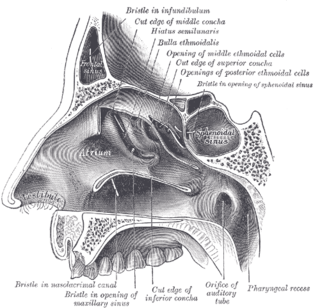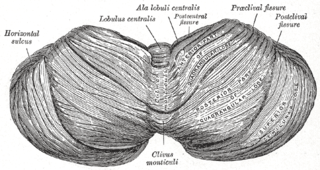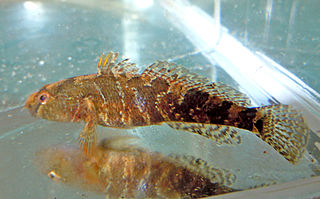Related Research Articles

The nictitating membrane is a transparent or translucent third eyelid present in some animals that can be drawn across the eye from the medial canthus to protect and moisten it while maintaining vision. Some reptiles, birds, and sharks have full nictitating membranes; in many mammals, a small, vestigial portion of the nictitating membrane remains in the corner of the eye. Some mammals, such as cats, camels, polar bears, seals and aardvarks, have full nictitating membranes. Often called a third eyelid or haw, it may be referred to in scientific terminology as the plica semilunaris, membrana nictitans, or palpebra tertia.

In the ethmoid bone, a sickle shaped projection, the uncinate process, projects posteroinferiorly from the ethmoid labyrinth. Between the posterior edge of this process and the anterior surface of the ethmoid bulla, there is a two-dimensional space, resembling a crescent shape. This space continues laterally as a three-dimensional slit-like space - the ethmoidal infundibulum. This is bounded by the uncinate process, medially, the orbital lamina of ethmoid bone, laterally, and the ethmoidal bulla, posterosuperiorly. This concept is easier to understand if one imagine the infundibulum as a prism so that its medial face is the hiatus semilunaris. The "lateral face" of this infundibulum contains the ostium of the maxillary sinus, which, therefore, opens into the infundibulum.

The semilunar hiatus or hiatus semilunaris, is a crescent-shaped groove in the lateral wall of the nasal cavity just inferior to the ethmoid bulla. It is the location of the openings for maxillary sinus. It is bounded inferiorly and anteriorly by the sharp concave margin of the uncinate process of the ethmoid bone, superiorly by the ethmoid bulla, and posteriorly by the middle nasal concha.
On the lateral wall of the middle meatus is a curved fissure, the hiatus semilunaris, limited below by the edge of the uncinate process of the ethmoid and above by an elevation named the ethmoid bulla ; the middle ethmoidal cells are contained within this bulla and open on or near to it.

The plica semilunaris is a small fold of bulbar conjunctiva on the medial canthus of the eye. It functions during movement of the eye, to help maintain tear drainage via the lacrimal lake, and to permit greater rotation of the globe, for without the plica the conjunctiva would attach directly to the eyeball, restricting movement. It is the vestigial remnant of the nictitating membrane which is drawn across the eye for protection, and is present in other animals such as birds, reptiles, and fish, but is rare in mammals, mainly found in monotremes and marsupials. Its associated muscles are also vestigial. It is loose, thus eye movements are not restricted by it. Only one species of primate, the Calabar angwantibo, is known to have a functioning nictitating membrane.

The linea semilunaris is a curved tendinous intersection found on either side of the rectus abdominis muscle.

The lacrimal caruncle, or caruncula lacrimalis, is the small, pink, globular nodule at the inner corner of the eye. It is made of skin covering sebaceous and sweat glands.

The hiatus semilunaris is bounded inferiorly by the sharp concave margin of the uncinate process of the ethmoid bone, and leads into a curved channel, the infundibulum, bounded above by the bulla ethmoidalis and below by the lateral surface of the uncinate process of the ethmoid.
Plica semilunaris can refer to:
The plica semilunaris is the thin upper part of the fold of mucous membrane in the supratonsillar fossa that reaches across between the two arches. A separate fold is called the plica triangularis which runs inferoposteriorly from the posterior surface of the palatoglossal arch to cover the inferior portion of the tonsil.

The folium vermis is a short, narrow, concealed band at the posterior extremity of the vermis, consisting apparently of a single folium, but in reality marked on its upper and under surfaces by secondary fissures.
Plica may refer to:

The western tubenose goby is a species of goby native to fresh waters of the Black Sea and Aegean Sea basins,. It has recently spread as an invasive species to Central and Western Europe and to North America. Previously Proterorhinus semilunaris was considered as a junior synonym of Proterorhinus marmoratus, but was confirmed as a distinct species based on molecular analysis.

Proterorhinus is a genus of fishes, known as the tubenose gobies. These gobiid fish are native to Eurasia where they occur in the region of the Caspian and Black seas, inhabiting marine, brackish and fresh waters. The species Proterorhinus semilunaris was introduced to the St. Clair River in Michigan during the late 1990s. Until recently, the genus was considered monotypic, comprising only the tubenose goby. Following molecular and further morphological investigations it has been split into several taxa, with distinct distributions in marine vs. fresh waters and in the Black Sea vs. Caspian Sea basins.
Glyphipterix semilunaris is a moth in the family Glyphipterigidae. It was described by Edith Wollaston in 1879 and is known from Saint Helena in the South Atlantic Ocean.

In anatomy, the term nasal meatus can refer to any of the three meatuses (passages) through the skull's nasal cavity: the superior meatus, middle meatus, and inferior meatus.

Pterolophia is a genus of longhorn beetles of the subfamily Lamiinae, containing the following species:
Sybra semilunaris is a species of beetle in the family Cerambycidae. It was described by Breuning in 1939.
Pterolophia guineensis is a species of beetle in the family Cerambycidae. It was described by James Thomson in 1864, originally under the genus Alyattes.
References
- ↑ BioLib.cz - Pterolophia semilunaris. Retrieved on 8 September 2014.